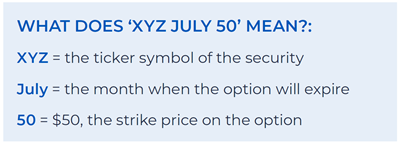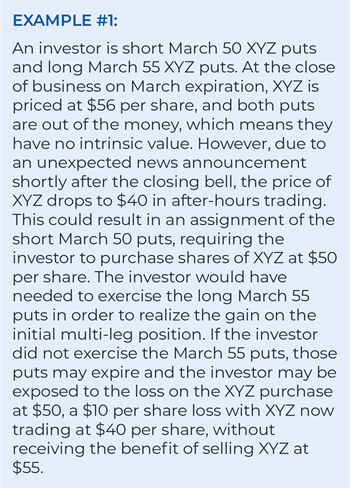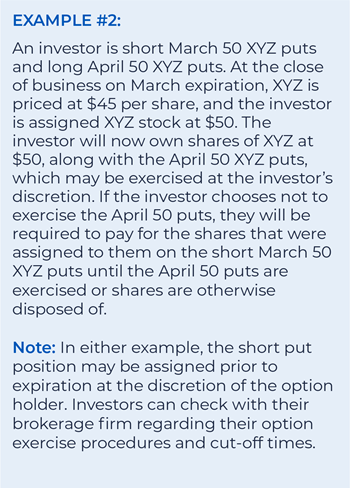Trading Options: Understanding Assignment

OCC/OIC and FINRA collaborated to create this primer on options assignment.
DOWNLOAD ARTICLE (PDF)
The options market can seem to have a language of its own. To the average investor, there are likely a number of unfamiliar terms, but for an individual with a short options position—someone who has sold call or put options—there is perhaps no term more important than ‘assignment’—the fulfilling of the requirements of an options contract.

Options trading carries risk and requires specific approval from an investor’s brokerage firm. For information about the inherent risks and characteristics of the options market, refer to the Characteristics and Risks of Standardized Options also known as the Options Disclosure Document (ODD). .png)
When someone buys options to open a new position (Buy to Open), they are buying a right — either the right to buy the underlying security at a specified price (the strike price) in the case of a call option, or the right to sell the underlying security in the case of a put option.
On the flip side, when an individual sells, or writes, an option to open a new position (Sell to Open), they are accepting an obligation — either an obligation to sell the underlying security at the strike price in the case of a call option or the obligation to buy that security in the case of a put option. When an individual sells options to open a new position, they are said to be ‘short’ those options. The seller does this in exchange for receiving the option’s premium from the buyer.
Options A-Z: The Basics to the Greeks or access free courses like Options 101 at OCC Learning.
American-style options allow the buyer of a contract to exercise at any time during the life of the contract, whereas European-style options can be exercised only during a specified period just prior to expiration. For an investor selling American-style options, one of the risks is that the investor may be called upon at any time during the contract’s term to fulfill its obligations. That is, as long as a short options position remains open, the seller may be subject to ‘assignment’ on any day equity markets are open.
What is assignment?
An option assignment represents the seller’s obligation to fulfill the terms of the contract by either selling or buying the underlying security at the exercise price. This obligation is triggered when the buyer of an option contract exercises their right to buy or sell the underlying security.
To ensure fairness in the distribution of American-style and European-style option assignments, The Options Clearing Corporation (OCC), which is the options industry clearing house, has an established process to randomly assign exercise notices to firms with an account that has a short option position. Once a firm receives an assignment, it then assigns this notice to one of its customers who has a short option contract of the same series. This short option contract is selected from a pool of such customers, either at random or by some other procedure specific to the brokerage firm.
How does an investor know if an option position will be assigned?
While an option seller will always have some level of uncertainty, being assigned may be a somewhat predictable event. Only about 7% of options positions are typically exercised, but that does not imply that investors can expect to be assigned on only 7% of their short positions. Investors may have some, all or none of their short positions assigned.
And while the majority of American-style options exercises (and assignments) happen on or near the contract’s expiration, a long options holder can exercise their right at any time, even if the underlying security is halted for trading. Someone may exercise their options early based upon a significant price movement in the underlying security or if shares become difficult to borrow as the result of a pending corporate action such as a buyout or takeover.
Note: European-style options can only be exercised during a specified period just prior to expiration. In
U.S. markets, the majority of options on commodity and index futures are European-style, while options on stocks and exchange-traded funds (ETF) are American-style. So, while SPDR S&P 500, or SPY options, which are options tied to an ETF that tracks the S&P 500, are American-style options, S&P 500 Index options, or SPX options, which are tied to S&P 500 futures contracts, are European-style options.
What happens after an option is assigned?
An investor who is assigned on a short option position is required to meet the terms of the written option contract upon receiving notification of the assignment. In the case of a short equity call, the seller of the option must deliver stock at the strike price and in return receives cash. An investor who doesn’t already own the shares will need to acquire and deliver shares in return for cash in the amount of the strike price, multiplied by 100, since each contract represents 100 shares. In the case of a short equity put, the seller of the option is required to purchase the stock at the strike price.
How might an investor’s account balance fluctuate after opening a short options position?
It is normal to see an account balance fluctuate after opening a short option position. Investors who have questions or concerns or who do not understand reported trade balances and assets valuations should contact their brokerage firm immediately for an explanation. Please keep in mind that short option positions can incur substantial risk in certain situations.
For example, say XYZ stock is trading at $40 and an investor sells 10 contracts for XYZ July 50 calls at $1.00, collecting a premium of $1,000, since each contract represents 100 shares ($1.00 premium x 10 contracts x 100 shares). Consider what happens if XYZ stock increases to $60, the call is exercised by the option holder and the investor is assigned. Should the investor not own the stock, they must now acquire and deliver 1,000 shares of XYZ at a price of $50 per share. Given the current stock price of $60, the investor’s short stock position would result in an unrealized loss of $9,000 (a $10,000 loss from delivering shares $10 below current stock price minus the $1,000 premium collected earlier).

Note: Even if the investor’s short call position had not been assigned, the investor’s account balance in this example would still be negatively affected—at least until the options expire if they are not exercised. The investor’s account position would be updated to reflect the investor’s unrealized loss—what they could lose if an option is exercised (and they are assigned) at the current market price. This update does not represent an actual loss (or gain) until the option is actually exercised and the investor is assigned.
What happens if an investor opened a multi-leg strategy, but one leg is assigned?
American-style option holders have the right to exercise their options position prior to expiration regardless of whether the options are in-, at- or out-of-the-money. Investors can be assigned if any market participant holding calls or puts of the same series submits an exercise notice to their brokerage firm. When one leg is assigned, subsequent action may be required, which could include closing or adjusting the remaining position to avoid potential capital or margin implications resulting from the assignment. These actions may not be attractive and may result in a loss or a less-than-ideal gain.
If an investor’s short option is assigned, the investor will be required to perform in accordance with their obligation to purchase or deliver the underlying security, regardless of the overall risk of their position when taking into account other options that may be owned as part of the overall multi-leg strategy. If the investor owns an option that serves to limit the risk of the overall spread position, it is up to the investor to exercise that option or to take other action to limit risk.
Below are a couple of examples that underscore how important it is for every investor
to understand the risks associated with potential assignment during market hours and potentially adverse price movements in afterhours trading.


.png)
For options-specific questions, you may contact OCC’s Investor Education team at options@theocc.com or subscribe to the OIC newsletter. If you have questions about options trading in your brokerage account, we encourage you to contact your brokerage firm. If after doing so you have not resolved the issue or have additional concerns, you can contact FINRA. Subscribe to FINRA’s newsletter for more information about saving and investing.

